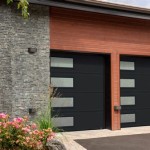Smart Storage: Bicycle Hooks For Your Garage Door
Bicycles represent a significant investment for many individuals, whether for recreational use, commuting, or competitive cycling. Proper storage is essential not only to protect the bicycle from damage and theft but also to maintain an organized and clutter-free living space. Garages, often the default storage location for bicycles, can quickly become overwhelmed by bikes leaning precariously against walls or taking up valuable floor space. Bicycle hooks designed for garage doors offer an innovative and efficient solution to this common storage challenge.
These hooks leverage the often-underutilized vertical space of the garage door, providing a secure and accessible location to store bicycles. The concept is relatively simple: specially designed hooks are attached to the garage door panels, allowing bicycles to be hung vertically or horizontally. This method keeps bicycles off the floor, minimizing the risk of tripping hazards and freeing up space for vehicles, tools, and other storage items. The market offers a variety of bicycle hooks designed for garage doors, each with its own set of features, weight capacities, and installation methods. Selecting the correct type of hook is crucial for ensuring the safety of the bicycles and the integrity of the garage door.
Key Considerations Before Installation
Before installing bicycle hooks on a garage door, several factors must be carefully evaluated. Ignoring these considerations can lead to damage to the garage door, instability of the stored bicycles, and potential safety hazards. These considerations relate to the garage door’s construction, operational mechanisms, and the specific needs of the user.
Firstly, the type and material of the garage door are paramount. Many modern garage doors are constructed from sectional panels made of steel, aluminum, or composite materials. Older doors might consist of a single solid panel, often made of wood. The material and construction method will significantly impact the load-bearing capacity and the suitability of different types of bicycle hooks. Steel and aluminum doors generally offer greater strength and durability compared to wooden doors, but they may be more susceptible to damage from improper drilling or installation techniques. Composite doors offer a balance between strength and resistance to weather, but the specific composition will dictate the appropriate attachment method. Solid-panel doors, while potentially strong, may not be ideal if the added weight significantly affects the door's balance and operation.
Secondly, the garage door's operating mechanism plays a crucial role. Most modern garage doors utilize a spring-loaded system, either torsion springs mounted above the door or extension springs running along the sides. These springs counterbalance the weight of the door, allowing it to be easily opened and closed. Adding significant weight to the door, such as multiple bicycles, can disrupt this balance, potentially causing the door to operate unevenly, strain the spring mechanism, or even fail completely. It is vital to consult with a garage door professional to determine the added weight capacity of the door and whether the springs need adjustment or replacement to accommodate the added load. Doors with weakened or improperly adjusted springs present a significant safety hazard.
Thirdly, the weight and type of bicycles to be stored are important. Lightweight road bikes will place less stress on the garage door and hooks compared to heavier mountain bikes or electric bikes. The hook system must be rated to support the combined weight of all bicycles to be stored. Furthermore, the design of the bicycles themselves will influence the type of hook required. Some hooks are designed to hold bicycles by the frame, while others utilize the wheels. The frame style, tire size, and overall geometry of the bicycle must be compatible with the chosen hook type. It is also necessary to consider the potential for future changes in bicycle ownership. Choosing a hook system with a higher weight capacity and adjustable features will provide greater flexibility in the long run.
Types of Bicycle Hooks and Their Installation
The market offers a diverse array of bicycle hooks designed for garage doors, each with its own installation method, weight capacity, and compatibility with different bicycle types and garage door materials. Understanding the various options is essential for selecting the most appropriate solution for a specific situation.
One common type is the screw-in hook. These hooks are typically made of heavy-duty steel and feature a threaded shaft that screws directly into the garage door panel. They are relatively easy to install, requiring only a drill and screwdriver, and can provide a secure and reliable attachment point. However, the installation process involves drilling holes into the garage door, which can potentially weaken the panel and void the warranty. It is crucial to select the correct drill bit size and avoid over-tightening the screws, which can strip the threads or damage the surrounding material. Screw-in hooks are best suited for garage doors made of solid wood or thick composite materials, where the screws can obtain a firm grip. They may not be appropriate for thin steel or aluminum doors, as the screws may not hold securely.
Another option is adhesive-mounted hooks. These hooks utilize a strong adhesive backing to attach to the garage door surface. They offer a non-invasive installation method, avoiding the need for drilling and minimizing the risk of damage to the door. However, the adhesive strength can be affected by temperature fluctuations, humidity, and the cleanliness of the surface. It is essential to thoroughly clean the garage door surface before applying the adhesive and to allow the adhesive to cure completely before hanging any bicycles. Adhesive-mounted hooks are generally suitable for lighter bicycles and smoother garage door surfaces. They may not be reliable for heavier bicycles or textured surfaces. Furthermore, the long-term durability of the adhesive bond can be uncertain, and the hooks may eventually detach over time.
Clamp-on hooks offer a third alternative. These hooks attach to the garage door panel using a clamping mechanism, providing a secure and adjustable attachment point without requiring drilling or adhesives. The clamping mechanism typically consists of a metal bracket that wraps around the edge of the door panel and is secured with screws or bolts. Clamp-on hooks are relatively easy to install and can be adjusted to accommodate different bicycle sizes and frame styles. They are suitable for a variety of garage door materials and can provide a strong and stable attachment point. However, the clamping mechanism can potentially damage the door panel if over-tightened or improperly installed. It is essential to follow the manufacturer's instructions carefully and to avoid applying excessive pressure to the clamping mechanism.
Safety and Maintenance
Proper installation and selection of bicycle hooks are only the initial steps in ensuring safe and effective bicycle storage. Ongoing maintenance and adherence to safety guidelines are critical for preventing accidents and maximizing the lifespan of the system.
Regular inspection of the hooks and garage door is paramount. This includes checking for any signs of wear, corrosion, or loosening of the attachment points. Inspect the screws, adhesives, or clamps for any damage or deterioration. If any issues are detected, they should be addressed promptly to prevent further degradation. For example, loose screws should be tightened, damaged adhesives should be replaced, and corroded metal parts should be cleaned and treated with a protective coating. Ignoring these issues can lead to a gradual weakening of the system and an increased risk of failure.
Maintaining the proper weight distribution is also essential. Avoid overloading the hooks beyond their rated weight capacity. Distribute the weight evenly across the hooks to prevent excessive stress on any single attachment point. Regularly re-evaluate the bicycles being stored and adjust the hook system accordingly. If heavier bicycles are added, it may be necessary to upgrade the hooks or reinforce the garage door. Similarly, if lighter bicycles are removed, the hooks can be adjusted to maintain optimal weight distribution.
Additionally, it's important to educate all users about the proper use of the bicycle hooks. This includes teaching them how to safely lift and hang bicycles, how to secure the bicycles properly, and how to identify potential safety hazards. Children should be supervised when accessing bicycles stored on the garage door. Clear instructions should be posted near the hooks, outlining the proper procedures and safety precautions. Regularly review these instructions with all users to ensure they are fully understood and followed. This can help prevent accidents and ensure the long-term safety and effectiveness of the bicycle storage system.

Saris Cycle Glide 4 Bike Hanging Storage Rack System

13 Bike Storage Ideas You Can Buy Or Diy 2024

Saris Cycle Glide 4 Best Space Saving Bike Storage Solution

13 Bike Storage Ideas You Can Buy Or Diy 2024

How To Bikes In Your Garage The Ultimate Guide

Ryobi Link Bike Hook Stm809 The Home Depot

The 4 Best Bike Storage Ideas Of 2025 Reviews By Wirecutter

13 Bike Storage Ideas You Can Buy Or Diy 2024

The 4 Best Bike Storage Ideas Of 2025 Reviews By Wirecutter

How To Bikes In The Garage Create More Space Mr Handyman
Related Posts








